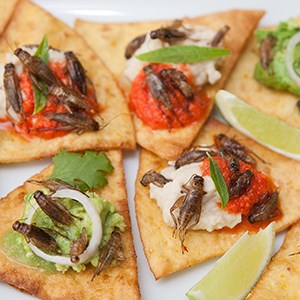Contact
Åsa Berggren, professor
Department of Ecology, SLU
asa.berggren@slu.se +46 (0)18-672344

With an increasing human population and non-sustainability of much of today’s agricultural systems, there is a need to change the way we produce food. Nutritious food that can sustain people but that allows other living organisms on the planet to thrive and wild habitats to remain. Insects are used as food in many regions around the world and studies indicate that several species are likely to be suitable for human consumption.
The ability of insects to eat and grow efficiently on agricultural by-products show that they could be an important part in creating sustainable food systems. These food systems are rapidly developing but still in their infancy. This means we can work within this industry to answer questions needed to ensure we achieve long-term sustainability and highlight where relevant problems are.
Food systems based on insects are not sustainable by default. Insects as food is promising, but we have yet to understand how these systems should look like for the insect species that are to be utilised. In our research we focus on ecological sustainability, and how this is incorporated into social and economic sustainability. In ecologically sustainable food systems all resources have to be used in a very efficient way without environmental costs. Looking at current food systems is informative for identifying associated environmental problems, as we work to find solutions to these issues: such as removal of native ecosystems in favour of production of feed crops and areas for grazing, and the use of fertilizers and pesticides that degrade the environment. This means that to build a new sustainable food system, novel solutions must be found in several crucial aspects. In our research we increase our understanding of vital ecological factors for development of sustainable insect-food systems by focussing on the house cricket Acheta domesticus. We study how individuals can be reared with resource efficiency and a low environmental impact. Our studies examine how individuals respond to different husbandry factors and relate these to sustainability criteria and animal development and health.
As insect-rearing facilities shift into mass-rearing, individual insects are likely to experience situations where some of their needs are not sufficiently met or they are subjected to new pathogens or disease exposure pathways. We have identified that high housing densities and little control or knowledge of existing pathogens are two major factors influencing this. Thus our research examines what microorganisms are present in reared insects so we can begin to design rearing methods to counteract the effects. In our research we examine the microbiota of one of the main food insects, the house cricket Acheta domesticus. We are exploring its microbiota communities in both wild and reared populations and how this relates to different aspects of their health, growth and how the species interact with their environment.
There are a very few insect species that are domesticated. Honeybees Apis mellifera and the silk moth Bombyx mori are two. To understand how wild species can be sustainably reared in environments that are totally different from what they have evolved in, we need a lot of new knowledge. This includes how the species live in their natural environment; their interaction with the environment (abiotic as well as biotic interactions) and interactions within the species. This knowledge will form the base for a new setting where the species are reared in an ecologically sound way. Thus, we work with identifying the traits that ensure these species live well under rearing conditions, stay healthy, reproduce and grow. For this we focus on the species’ natural ecology and include physiological as well as behavioural, reproduction and development traits.
Åsa Berggren, professor
Department of Ecology, SLU
asa.berggren@slu.se +46 (0)18-672344